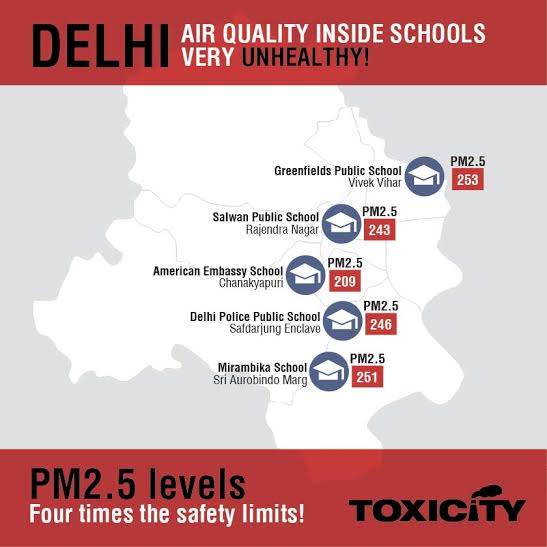April 26, 2024 01:45 (IST)

Air Quality inside Delhi schools very unhealthy: Greenpeace
New Delhi, Feb 16 (IBNS): The air-quality monitoring survey carried out by Greenpeace inside five prominent schools across Delhi found the PM2.5 levels to be 4 times the Indian safety limits and 10 times that of the World Health Organisation’s.
The real-time monitoring data from all the five schools revealed particulate matter 2.5 to be at very unhealthy levels.
According to the World Health Organization, air pollution impacts the most vulnerable sections of the population and children are among the worst hit. Studies by US Environmental Protection Agency (USEPA) have concluded that exposure to PM2.5 in children will mean reduced lung functioning, increase in asthma and respiratory illnesses. The International Agency for Research on Cancer classified particulate matter pollution as carcinogenic to humans in 2013, and designated it as a “leading environmental cause of cancer deaths”.
The annual PM2.5 averages of Delhi are higher than that of Beijing and this winter, Delhiites witnessed several bad-air days with the Air Quality Index averaging at critical pollution levels.
“This establishes the fact that air pollution levels inside Delhi’s schools are alarmingly high and that children are consistently breathing bad air. The government needs to acknowledge the severity of air pollution in the city and its corresponding health impacts. Our monitoring results, though conducted towards the end of winter revealed very high levels of particulate pollution inside the school premises, and in peak winter these numbers could only be worse. It is appalling to see that there are no health advisory measures in place for Delhiites on heavy pollution days, said Aishwarya Madineni, campaigner with Greenpeace.
The exponential rise in the air pollution levels and the reliability of the monitoring data has triggered the need for more robust monitoring mechanisms and a greater need for awareness of the health risks caused by air pollution.
Expressing concern over the rising trend in the pollution levels, Dr Vikram Jaggi, Director of Asthma and Allergy Centres said, “The winter of 2014 has particularly been a bad one for the asthmatics, the consistency in the smog resulted in an increased number of asthma cases for almost a period of three months.” According to the Centre of Occupational Environment and Health Director, Dr T.K Joshi, first indicators of air pollution are felt upon the mucous membranes, eyes and nasal cavities. A common problem faced by Delhiites on a daily basis is eye irritation and watering in the eye and exposure to such high levels of pollution will mean serious health damages in the long run.
Unlike Beijing on bad-air days, Delhi has neither the precautionary measures nor a health advisory in place to safe-guards its citizens from hazardous levels of pollution in the air.[ii]
Demanding action from the Delhi and central government, Aishwarya concluded, “The Delhi government needs to act on it now rather than later. While we agree that there needs to be a comprehensive effort from the government to curb the pollution levels, the more immediate need is for the precautionary measures that can ensure the health and safety of the children and citizens of Delhi”.
A brief Health Advisory on tackling air pollution in Delhi
By Dr. T.K. Joshi, Director – COEH, Delhi and Dr.Vikram Jaggi, Director Asthma Chest Allergy Centres, Delhi
· Find out the air pollution level in your area by visiting the Delhi Pollution Control Committee (DPCC) website “Real time Data” where air pollution levels are revised every hour.
· Look at the reference value/prescribed standard to know how bad the pollution is at any given time
· During hot summer months in some areas, levels of ozone are five times higher in the afternoon than in the morning, while in the winter the mid or late afternoon may be the time of lowest pollution.
· Limit children's outdoor exercise when levels of PM 10, PM2.5 , Ozone, Sulfur Dioxide, or Nitrogen Dioxide are on the higher side
· School should have plans for high air pollution episodes, including alerting teachers, curtailing sports or exercise programs, and providing alternative activities that do not involve heavy physical exertion.
· Children with asthma and other lung diseases are especially vulnerable to air pollution. During episodes of poor air quality, health monitoring of the children should be carried out and a physician having expertise to handle/treat such cases should be always at hand or be kept in the loop.
· Asthmatics know that their symptoms vary with seasons and weather. They should factor in the effect of pollution levels on their asthma too. And learn to take appropriate action.
· Asthma situation can be self assessed by a simple and inexpensive device called the Peak Flow Meter.
· During times of peak pollution levels, the asthmatics should take their preventative inhalers REGULARLY.
Support Our Journalism
We cannot do without you.. your contribution supports unbiased journalism
IBNS is not driven by any ism- not wokeism, not racism, not skewed secularism, not hyper right-wing or left liberal ideals, nor by any hardline religious beliefs or hyper nationalism. We want to serve you good old objective news, as they are. We do not judge or preach. We let people decide for themselves. We only try to present factual and well-sourced news.
Support objective journalism for a small contribution.
Latest Headlines
UN officials launch global campaign to combat climate emergency Wed, Apr 24 2024
Satellite imagery shows significant expansion in 27% identified glacial lakes in Himalayas: ISRO Tue, Apr 23 2024
Taiwan hit by 93 aftershocks, strongest touches 6.3 magnitude Tue, Apr 23 2024
World Meteorological Organization data shows heatwave deaths increased across almost all Europe in 2023 Mon, Apr 22 2024
Google marks World Earth Day with a unique doodle which gives a strong message to people Mon, Apr 22 2024
Vattikuti Foundation announces Brady-Vattikuti Robotic Academy hands-on masterclass in Urology Sat, Apr 20 2024
WHO expresses concern over spread of avian influenza to humans Fri, Apr 19 2024







